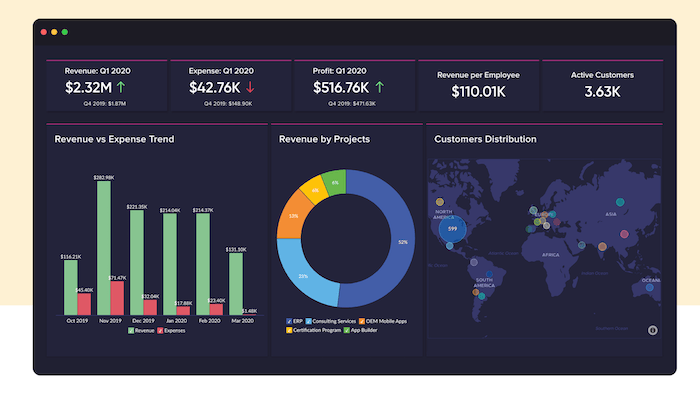Hello!
A Business Intelligence platform, also known as a Management solution, is software application which really receives and analyzes large amounts of data on both various business sources like journals, booklets, files, metadata, email messages, photos, video clips, and so forth.
While these tools are not as adaptable as Business Intelligence tools, individuals do provide several methods for handling data in order to obtain data via queries.Furthermore, these tools enable BI experts to start preparing information before evaluating it to create dashboards, news stories, and graphical representations.
 This results in an end result that gives all employees in the workplace the ability to make the right decisions, recognize impending revenue streams, define the most recent possibilities for advancement, boost operational efficiency, perceive market dynamics, and more.
This results in an end result that gives all employees in the workplace the ability to make the right decisions, recognize impending revenue streams, define the most recent possibilities for advancement, boost operational efficiency, perceive market dynamics, and more.
Now let us examine why all these techniques are required, and then we will look at the multiple business Reporting tools.
Why BI Tools Are Important?
BI tools have been typically used for querying as well as transforming the company on records, but they would also merge a diverse range of processes for statistical analysis. Enterprise investigating, legitimate BI, mobile BI, online analytical (OLAP), organisational BI, open-source BI, ad hoc, and other apps may be included.
 Furthermore, those who entail data visualization applications that enable different tools and graphs to good quality benchmarks and dashboards that exhibit KPIs and key metrics.
Furthermore, those who entail data visualization applications that enable different tools and graphs to good quality benchmarks and dashboards that exhibit KPIs and key metrics.
Furthermore, these simple visualization tools help practitioners to put relevant information to life to make sense of it.
And here’s a summary of the most popular BI tool illustrations which are used regularly and in a variety of organizational operations.
7 Business Intelligence Tools Every Enterprise Must Use:
Tableau:
Tableau was among the most famous and straightforward Microsoft Information systems being used today. Tableau seems to be a popular BI platform that ranks high upon the best BI tools list. With that kind of integrated tool, many non-technical users can access individualized dashboards and reports to obtain crucial data.
Furthermore, it offers a diverse range of available data that are both immersive and satisfying. This tool primarily serves two purposes: data gathering and statistical analysis. It collects information from a variety of sources, including word documents and distributed computing. The whole Data Analysis technology is being used in a variety of industry sectors, such as financial services, manufacturing, and education.
Features Include:
 Dashboards as well as tools for performing target market on every given dataset could be shared.
Dashboards as well as tools for performing target market on every given dataset could be shared.
You can choose from two versions: the 32-bit version as well as the 64-bit version.
This has a faster information update feature, that also helps the participants to obtain the most up-to-date data but also derive insights from this in real-time.
The device can be installed on a local machine or in the cloud.
Sisense:
The primary goal of the BI tool Sisense is to collect, evaluate, and conceptualize datasets of any size. Everything just is among the most commonly used control panel BI tools, with such an adaptive feature which really provides an user-friendly drag-and-drop functionality, enabling anyone, such as those without an IT backdrop, to use it and recognize it.
In Sisense, users must record and analyze data in a centralized computer that stores for mapping and monitoring. Furthermore, users could use information to create dashboards using the software’s numerous imagery and research tools. Furthermore, users can start sharing dashboards and reports to your members of the team and other departments of the organization, and also with external audiences. This enables businesses to analyze various issues and make accurate business growth strategies.
QlikView:
QlikView is a popular business intelligence (BI) tool which really makes it possible to create apps, dashboards, as well as visualizations. Furthermore, QlikView offers a detailed overview of the data held in your data.
Its simple drag-and-drop characteristic helps to create immersive and infinitely customizable visualization tool.Natural quest can be used to traverse and connect directly large amounts of information.It reacts rapidly to emerging, notifications, and encounters.It accepts a variety of file formats and information sources.
Looker:
 Looker seems to be a business intelligence app for startup companies and small and medium-sized businesses. It integrates with nearly every Database system or storage facility, such as Redshift, Snowflake, and BigQuery, and is incredibly simple to use.
Looker seems to be a business intelligence app for startup companies and small and medium-sized businesses. It integrates with nearly every Database system or storage facility, such as Redshift, Snowflake, and BigQuery, and is incredibly simple to use.
One such BI tool includes potent additional capabilities which really allow people to connect predictive analytics and reviews via email or third-party apps.
Customers will be able to use a multi-cloud strategic plan with various sources and implementation methods.
Looker gives data experts the ability to see each client all over touch points, enabling each other to reveal additional insight based on current encounters. This is an excellent method for understanding consumer behavioral intention, developing tailored messaging, as well as identifying sales promotional possibilities to enhance operational efficiencies.
Datapine:
datapine would be a business intelligence (BI) simple tool for companies of all sizes in a wide range of industries. It is appropriate both for advanced and median corporate customers. Devices can subscribe data from multiple sources, evaluate it, create dashboards, as well as create information using the framework.Datapine includes a SQL method that enable people to create specially made queries, as well as a drag-and-drop functionality that allows line-of-business people to make graphical representations without any need for sophisticated coding.
The platform often broadly includes analytics capabilities, such as predictive modeling predicated on a prediction engine. Consumers can choose KPIs, and choose the data sets they want to predict, specify prior datasets, and identify model’s performance by specifying a standard deviation.
Microsoft Power BI:
 Microsoft Power BI would be a software business intelligence package that aims at providing data visualizations which can be used across datacenters. It is intended for corporate environments, but it also allows users at all levels to make informed choices.
Microsoft Power BI would be a software business intelligence package that aims at providing data visualizations which can be used across datacenters. It is intended for corporate environments, but it also allows users at all levels to make informed choices.
Microsoft Power BI provides the flexibility for consumers to incorporate a variety of third-party applications. Consumers, for instance, could indeed attach Excel queries, data structures, and news stories to their control panels to collect, evaluate, and end up sharing business information.
The framework seamlessly integrates to Azure unstructured data, allowing users to easily start sharing big amounts of information with relevant parties. Furthermore, they are able to improve team work and successfully decrease the overall to obtain insights.
Domo BI Tool:
Domo would be a cloud-based business intelligence product that consists of various systems which allow users to connect to various sources (including datasets, spreadsheet applications, and social media) as well as broaden those to pre-built applications from Domo Appstore. The tool was developed for enterprise customers, but it can also be used among small companies with innovation data teams.
Domo enables customers to create data products to 1,000+ pre-built virtualized adapters and requests in which they are hosted. File upload (for instance, Google Docs or spreadsheet applications), proprietary information, and on-premise use of Domo Workstation are all examples of this.
 The platform not only includes Magic ETL, which allows consumers to access transformations without knowing SQL. This allows managers to accelerate predictive analytics procedures. Furthermore, Domo indicates visualization tools instantly, allowing teams to quickly transition from raw sources of data to charts, graphs, and layouts.
The platform not only includes Magic ETL, which allows consumers to access transformations without knowing SQL. This allows managers to accelerate predictive analytics procedures. Furthermore, Domo indicates visualization tools instantly, allowing teams to quickly transition from raw sources of data to charts, graphs, and layouts.
Mr. Roboto, Domo’s constructed AI engine, assists information team members in creating intelligent detection designs and enables them to use machine learning and artificial intelligence. Consumers can, for instance, configure this to notify them anytime KPIs change.
Conclusion:
Major decision executives, data team members, and interested parties can use BI insights to help comprehend high quantities of business information, evaluate it, and make rapid (and profitable) strategic decisions. Current self Bi systems keep it simple for almost anyone on a team to communicate and distribute data visualizations as well as gain knowledge quicker without coding.
Thank you!
Join us on social media!
See you!






